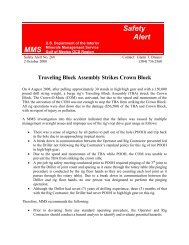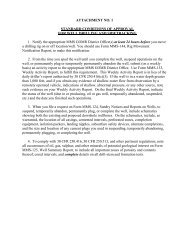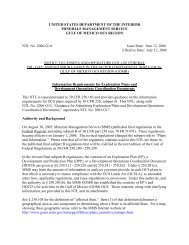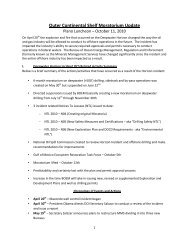Deepwater Gulf of Mexico 2004: America's Expanding ... - OCS BBS
Deepwater Gulf of Mexico 2004: America's Expanding ... - OCS BBS
Deepwater Gulf of Mexico 2004: America's Expanding ... - OCS BBS
- No tags were found...
Create successful ePaper yourself
Turn your PDF publications into a flip-book with our unique Google optimized e-Paper software.
Subsea systems, as shown in figure 45, are capable <strong>of</strong> producing hydrocarbons from reservoirs covering<br />
the entire range <strong>of</strong> water depths that industry is exploring. Subsea systems continue to be a key<br />
component in the success in deepwater to date. These systems are generally multi-component seafloor<br />
facilities that allow for the production <strong>of</strong> hydrocarbons in water depths that would normally preclude<br />
installing conventional fixed or bottom-founded platforms. The subsea system can be divided into two<br />
major components: the seafloor equipment and the surface equipment. The seafloor equipment will<br />
include some or all <strong>of</strong> the following: one or more subsea wells, manifolds, control umbilicals, and<br />
flowlines. The surface component <strong>of</strong> the subsea system includes the control system and other production<br />
equipment located on a host platform that could be located many miles from the actual wells.<br />
SUBSEA TRENDS<br />
Figure 46 shows the number <strong>of</strong> subsea completions each year since 1955 (only productive wells were<br />
counted). There were fewer than ten subsea completions per year until 1993. This number increased<br />
dramatically throughout the 1990’s. The pie chart within figure 46 shows that shallow-water subsea wells<br />
are a significant contribution to the subsea well population in the GOM. Shallow-water subsea wells<br />
accounted for 131 <strong>of</strong> the 295 total subsea wells in the GOM by yearend 2003. Operators have found<br />
subsea tiebacks to be valuable for shallow-water marginal fields because <strong>of</strong> the extensive infrastructure <strong>of</strong><br />
platforms and pipelines. Nonmajor companies have installed nearly all <strong>of</strong> these shallow-water subsea<br />
wells, led by Walter Oil and Gas Corporation with 35 wells. Figure 46 demonstrates the increasing<br />
reliance <strong>of</strong> industry on subsea technology to develop both shallow-water and deepwater fields, beginning<br />
in the late 1980’s.<br />
The technology required to implement subsea production systems in deepwater evolved significantly in<br />
the last decade. This evolution is apparent in figure 47, which shows the deepest subsea completion was<br />
in 350 ft (107 m) <strong>of</strong> water until 1988, when the water depth record (GOM) jumped to 2,243 ft or 684 m<br />
(Green Canyon 31 project). In 1996 another record was reached with a subsea completion in 2,956 ft<br />
(901 m) <strong>of</strong> water (Mars project), followed by a 1997 subsea completion in 5,295 ft (1,614 m) <strong>of</strong> water<br />
(Mensa project). Camden Hills has the deepest production in the GOM to date, in a water depth <strong>of</strong><br />
7,216 ft (2,199 m). A listing <strong>of</strong> productive subsea completions on the GOM Outer Continental Shelf can<br />
be found in Appendix G.<br />
Figure 48 further breaks down the subsea completion count into specific water depth ranges. This figure<br />
shows that 70 percent <strong>of</strong> the subsea completions are in water depths less than 2,500 ft (762 m).<br />
NEW PIPELINES<br />
The pipeline infrastructure to bring deepwater oil and gas onshore also expanded during the 1990’s. The<br />
pipeline from a subsea completion to the host platform is commonly referred to as the tieback. The<br />
tieback length varies considerably, as shown in figure 49. Most subsea wells are within 10 mi (16 km) <strong>of</strong><br />
the host platform, with the Mensa field remaining the current world record holder for a subsea tieback<br />
length <strong>of</strong> 62 mi (100 km) from the host platform. The second longest subsea tieback in the world (55 mi<br />
or 88 km) is Canyon Express, linking Aconcagua, Camden Hills, and King’s Peak projects to their host<br />
platform.<br />
<strong>Deepwater</strong> pipelines approved for installation are shown in figures 50a and 50b. The data include the<br />
total length <strong>of</strong> all pipelines originating at a deepwater development, including any shallow-water<br />
segments (control umbilicals are excluded). Figure 50a shows deepwater pipelines that are less than or<br />
equal to 12 inches (30.5 cm) in diameter. The dominance <strong>of</strong> gas pipeline miles approved in deepwater is<br />
surprising — 58 percent <strong>of</strong> the total since 1990. The large increase in 2001 in both oil and gas pipeline<br />
miles reflects approvals for Canyon Express (Aconcagua, Camden Hills, and King’s Peak fields), Horn<br />
Mountain, and the Boomvang-Nansen projects. Installation <strong>of</strong> large pipelines (greater than 12 inches<br />
[30.5 cm] in diameter) dramatically increased in 2002 after a brief downturn in activity in 2000 and 2001<br />
(figure 50b). The peak in 2002 was driven by the approval <strong>of</strong> the Mardi Gras system.<br />
70







